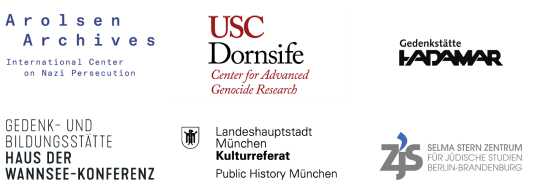Annotations
Dortmund
April/May 1942
After arriving in Zamość on May 3, 1942: The guard of the deportation train from Dortmund that consisted of municipal police officers, and the German personnel stationed at the station pose for a group photo in front of the station building.
Annotations
Keywords
2
Historical context
Deportation von Dortmund nach Zamość am 30.04.1942
In April 1942, the Dortmund Gestapo deported 791 Jews – 178 of them coming from Dortmund, the rest from the Arnsberg administrative district, including Hohenlimburg and Hattingen. On April 28, 1942, the persecutees from Dortmund had to gather in the gymnasium of the Eintracht sports club, which had been converted into an assembly camp, on what is now Rheinlanddamm (then Hindenburgdamm). On April 30, 1942, they had to board a 3rd class passenger train at the Dortmund-Süd freight station. Guarded by an escort team from the municipal police, the transport reached its destination after a three-day journey on May 3, 1942: the Zamość ghetto in the Lublin district. The deportees remained there for a few weeks only. It is probable that the National Socialists murdered all of them as part of their “Operation Reinhardt” agenda. None of the people deported in April 1942 are known to have survived.
About the image series
The series consists of two group photos of the municipal police officers that escorted the deportation from Dortmund to Zamość. The first of the pictures was taken before the train’s departure from the Dortmund-Süd train station on the morning of April 30, 1942, and the second one was taken in front of the entrance to the Zamość train station probably shortly after arrival on May 3, 1942. A third picture has survived as part of the series. It was taken from the moving train and showed Polish farmhouses along the route. It is unclear whether the photo was taken on the outward journey or on the escort’s return to Dortmund.
Photographer
Unknown, Police man
The photo was taken by one of the municipal police officers that escorted the deportation from Dortmund to Zamość. He took the photos as a "travel souvenir" and later distributed prints to his colleagues. His exact identity is not known.
Provenance
One of the municipal police officers involved took the photos and distributed them later, presumably as a souvenir, to colleagues also involved in the deportation. The original prints of the photos have survived in a photo album owned by one of the officers involved, which is in family possession. The family that wishes to remain anonymous, contacted Stadtarchiv Dortmund in 2014. An employee of the town archives made digital reproductions of the front and back pages and searched the album for more pictures that might relate to the deportation. The digital reproductions are preserved in Stadtarchiv Dortmund.
Call number at source archive
Ohne Signatur
Title at source archive
Ohne Titel
Acknowledgements
The description of the photos is largely based on earlier research by Stadtarchiv Dortmund and in particular by historian Rolf Fischer, who has conducted extensive research into the deportations starting out from Dortmund (cf. Rolf Fischer: Verfolgung und Vernichtung. Die Dortmunder Opfer der Shoah. Gedenkbuch, Essen 2015, pp. 110-137).
Text and research by Henning Borggräfe.
Kooperationsverbund #LastSeen. Bilder der NS-Deportationen Dr. Alina Bothe Projektleiterin
c/o Selma Stern Zentrum für Jüdische Studien Berlin-Brandenburg
Freie Universität Berlin
Habelschwerdter Allee 34A
14195 Berlin
lastseen@zedat.fu-berlin.de
Ein Kooperationsprojekt von

Gefördert durch

Datenschutz | Impressum